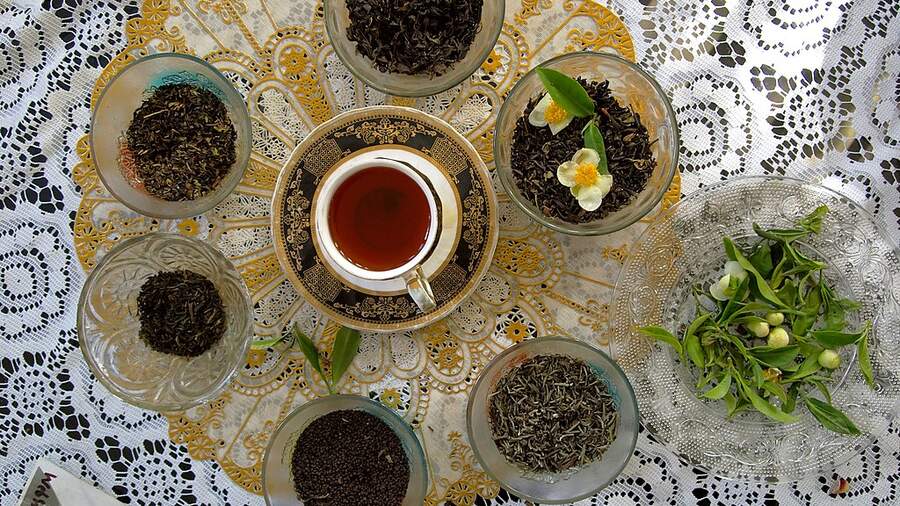Black Tea: A Beginner's Guide!
If you’re new to drinking black tea, this article will help you to understand how it can enhance your life (and taste buds)!

Soon after waking up, you curl up on the couch with a thick, knit blanket and a large cup of black tea that you’ve never tried before. The first sip is bold, rich, and energizing. Your eyelids, which were once heavy and tired are growing lighter. You feel more and more ready to start the day– but not quite yet. The tea is too delicious not to savor every last drop.
Regardless of whether or not you’re new to black tea, you’re capable of enjoying black tea in a similar way! This article will guide you from choosing the black tea that’s right for you, to preparing and enjoying it.
Black tea comes from the Camellia Sinensis plant, which is the same plant that the four other types of tea (green tea, oolong, white tea, and pu-erh) come from. What makes black tea stand out from the others is what happens after the leaves are harvested. (Check out the “Production” section of this article for more information.) The unique production process is what gives black tea its rich, malty flavor.
How to Taste Black Tea
In order to enjoy a black tea to its fullest potential, it’s important to learn a few keywords that describe flavors that might be found in different black teas.
Body is used to describe the spectrum of the mouthfeel that can be experienced in tea. Full-bodied teas (such as our Tanzania black tea) describe the experience of the rich and heavy mouthfeel in the tea.
Malty describes a full-bodied tea with a rich, sweet, and caramel-like flavor. This flavor is well-represented by black teas from the Assam region of India, which have bold flavors that pair well with milk and are frequently used as the base for chai, a type of spiced black tea.
Smoky flavors give the aroma of burning wood. This typically means that the tea was smoked when it was being produced, like Lapsang Souchong, which is a Chinese black tea with an intense smoky flavor.
Brisk describes a lively tartness that might be found in a black tea like Royal Yunnan. It’s also referred to as astringency– the physical sensation that causes the mouth to pucker.
Next time you’re enjoying a black tea, consider the adjectives I described above. Ask yourself if any of them describe the flavor.
In order to avoid mindlessly drinking black tea, so you’ve benefitted from all of the caffeine but none of the flavor, allow the tea to linger in your mouth for a longer period of time than you normally would, to give yourself the opportunity to notice nuances in the flavor.
The ability to savor a cup of tea is quite similar to a mediation practice. If you want to learn more about how you can pair drinking tea with mindfulness, you might enjoy this article.
The Art of Choosing Your Black Tea
The first step in choosing a black tea is curiosity! It’s helpful to ask yourself if any of the above adjectives are appealing.
Going to a shop dedicated to selling tea is helpful, because they spend a lot of time choosing enjoyable, high-quality tea. We have many varieties of black tea, available loose-leaf or in tea bags depending on personal preference.
If you’re looking for something with a specific flavor profile, here are some suggestions:
Crimson Ceylon is a medium-bodied, Sri Lankan tea with floral and woody notes. It’s incredibly smooth, but especially so if it’s cold brewed! (Learn how to cold brew a black tea in the ‘A Guide to Brewing Black Tea’ section of this article.) It brews a brilliant, deep red color that’s wonderful to look at.
If you’re on the hunt for a delightful full-bodied black tea with floral notes, look no further than Darjeeling Second Flush! It has a subtle, nutty, and malty flavor profile that’s sure to make you smile!
Golden Assam is fantastically bold and malty. It has a sweetness and subtle smoky flavor profile that’s perfect for warming up on a cold morning. It takes exceptionally well to milk, but is fantastic on its own.
Grand Keemun evokes a sense of joy and comfort, thanks to its notes of cocoa and plum. Because of its flavor notes, it’s incredibly versatile– perfect for everything from quenching thirst on a hot summer day to contributing coziness to the coldest day of the year.
Black tea, green tea, white tea, oolong and pu-erh all come from the same plant. What makes them differ from one another has to do with what is done with the leaves after harvest.
With different types of tea come different brewing times and temperatures. While green tea, for example, usually has a suggested brew of 2-3 minutes at 175 degrees Fahrenheit, black tea brews at 212 degrees for 4-5 minutes.
Since green tea has a lower brewing temperature and time, less caffeine is going to be pulled out of the leaves than black tea. While green tea has about 30 mg of caffeine per 8 oz cup, black tea yields around 47 mg per 8 oz.
A Guide to Brewing Black Tea
There are many ways to brew a cup of black tea, but here are are some instructions to point you in the right direction. Remember: if you enjoy the cup of tea that you made, you’re doing it right!
Hot Brew Black Tea
Step 1: Heat your water to a boil.
Step 2: While the water is heating up, grab the black tea of your choice. If you have a tea bag, put one in your cup. If it’s loose, put 1 tsp of tea (per 8 oz of water) in an infuser. If you don’t have one, we have some available here.
Step 3: Brew the tea for 4-5 minutes, and then remove the tea bag or infuser.
Step 4: You could enjoy the tea by itself, or you could add milk and/or sugar.
Step 5: Enjoy!
Cold Brew Black Tea
Step 1: Pour cold, filtered water into a mason jar or pitcher. We have pitchers available that are designed for cold brew tea that add convenience to the experience!
Step 2: If you’re using bagged tea, put one tea bag in the pitcher per 8 oz of water. If you’re using loose tea, put one teaspoon of tea per 8 oz of water into the infuser.
Step 3: Place the pitcher in a refrigerator for 8-12 hours.
Step 4: Remove the leaves, and consider your thirst, quenched!
A Brief History of Black Tea and its Production
In China during the mid-17th century, an army from Jianxi unexpectedly camped at a tea farm in the Fujian provence. Tea production was halted, and the leaves were left in the sun for a longer time period than normal, causing the leaves to turn a reddish-brown.
In an attempt to salvage the leaves, the farmer put them over a pinewood fire, which ended up smoking them. That’s how black tea (and specifically Lapsang Souchong, a variety of smoked black tea) was born!
Black tea comes from the Camellia Sinensis plant. During the curing process, black tea is oxidized for a longer period of time than the other types of tea, which is what gives it its dark color.
Recipes
There are many ways that you can have fun with black tea, here are just a few! Thai Iced Tea Earl Grey Hot Chocolate Black Tea Lemonade

